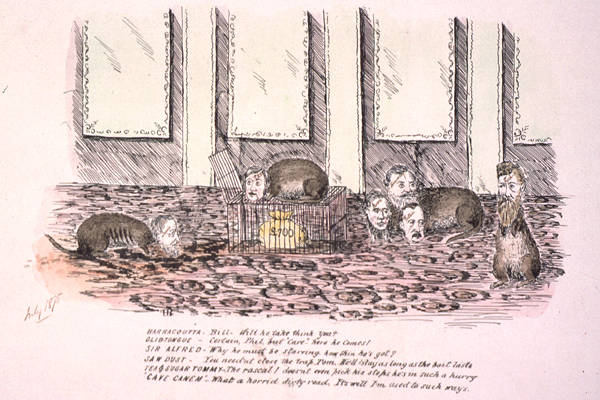 |
 |
|
Political Cartoons
Political Cartoons have featured in Tasmanian newspapers since the Cornwall Chronicle published some in 1836. A pamphlet featuring a political cartoon satirising Franklin's government was prevented from being delivered to the Legislative Council in 1839. The Tasmanian Punch (1866–79) was largely made up of cartoons, and later newspapers such as the Tasmanian Mail (Hobart) and the Weekly Courier (Launceston) published occasional cartoons. Photographer JW Beattie owned glass lantern slides featuring caricatures of Tasmanian personalities from the 1880s and 1890s. Some were signed by 'Hop' (Livingstone Hopkins of Bulletin fame) and others by Jack Hartnett. In the 1890s, Skits: a memento from the Tasmanian exhibition, Launceston (1892), (Alfred Vincent, 1892) and Exhibition frolics (PW Maroney, 1895) included caricatures of officials connected with the Launceston exhibition. W Walker also published cartoons in the 1890s. The most prolific Tasmanian cartoonist and caricaturist was Thomas 'Claude' Wade Midwood (1854–1912), a draftsman at the Public Works Department, who published in magazines and newspapers between 1878 and 1912. One of Tasmania's most famous cartoonists was Alexander Gurney (1902–55). Born in England, Gurney came to Tasmania in 1905, worked for the Hydro-Electric Commission and in 1926 published a book of caricatures, Tasmanians Today. He moved to the Melbourne Sun in 1946 and became one of the nation's best-loved cartoonists, drawing comic strips for many newspapers, the most famous being the larrikins Bluey and Curley and the Australian icon Ben Bowyang. Each became part of Australian folklore. After Gurney died, mainlanders Norman Ride and Leslie Dixon took over his work. With the exception of these cartoonists, Tasmanian newspapers largely ignored regular political cartoonists until the 1950s, when the Mercury employed Norm Southey as its first full-time cartoonist and press artist. He was replaced with Geoff 'Jeff' Hook in the mid-1950s. Hook got his start by drawing cartoons titled 'Jeff's Jests' in the Saturday Evening Mercury, and when he moved in 1964 to the Sun News Pictorial (later part of the Herald-Sun) he became one of Australia's best-loved political cartoonists, winning national and international awards. Hook's well-known trademark is the hook that he draws in every picture. Hook was succeeded at the Mercury by Kevin 'Kev' Bailey, who first came under notice when he displayed large caricatures of prominent staff members around the office walls. His obvious artistic talent enabled him to secure a job as a press artist and cartoonist for 25 years. In 1994 he was succeeded by John 'Polly' Farmer, whose accolades include a United Nations award in 2001. Other Mercury cartoonists include Jon Kudelka and Graeme 'Daze' Dazeley. The Examiner did not publish regular political cartoons until the 1970s when Allan Langoulant began to submit sketches. In 1982 he was replaced with Graeme 'Daze' Dazeley who sent cartoons from Hobart. Over 22 years Dazeley has submitted 9210 cartoons to newspapers. In 2000 the Examiner replaced him with Mike Woods. From the 1980s Allan 'Sols' Salisbury submitted a daily comic strip called 'Snake' to the Examiner. This proved so popular that it is widely published around the world. The remaining Tasmanian daily regional newspaper, the Advocate, has not published local political cartoons. Other freelance cartoonists or caricaturists to make their mark in Tasmania included Kingsley Fairweather in the 1940s, Eric Howroyd 1940s–1970s, Harold Virs and Neil Matterson in the 1970s, Louis Rodway in the 1980s and Chris Kelly, John Traynor, Tom Larkey and Rodney Phoebe in the 1990s. Further reading: AOT Correspondence Files 'Cartoons', 'Midwood' and 'Examiner'; Mercury, 14 July 2001; C Craig, The engravers of Van Diemen's Land, Launceston, 1961; Old Tasmanian prints, Launceston, 1964; More old Tasmanian prints, Launceston, 1983; and C Craig (ed), Mr Punch in Tasmania, Hobart, 1980. Wayne Smith |
Copyright 2006, Centre for Tasmanian Historical Studies |
